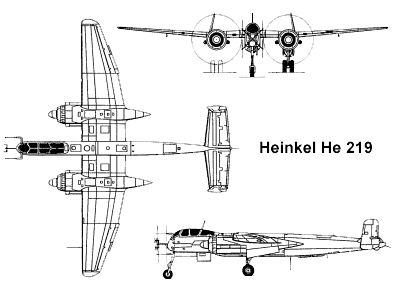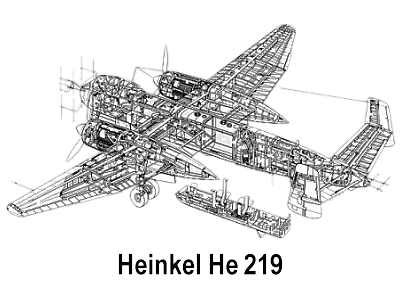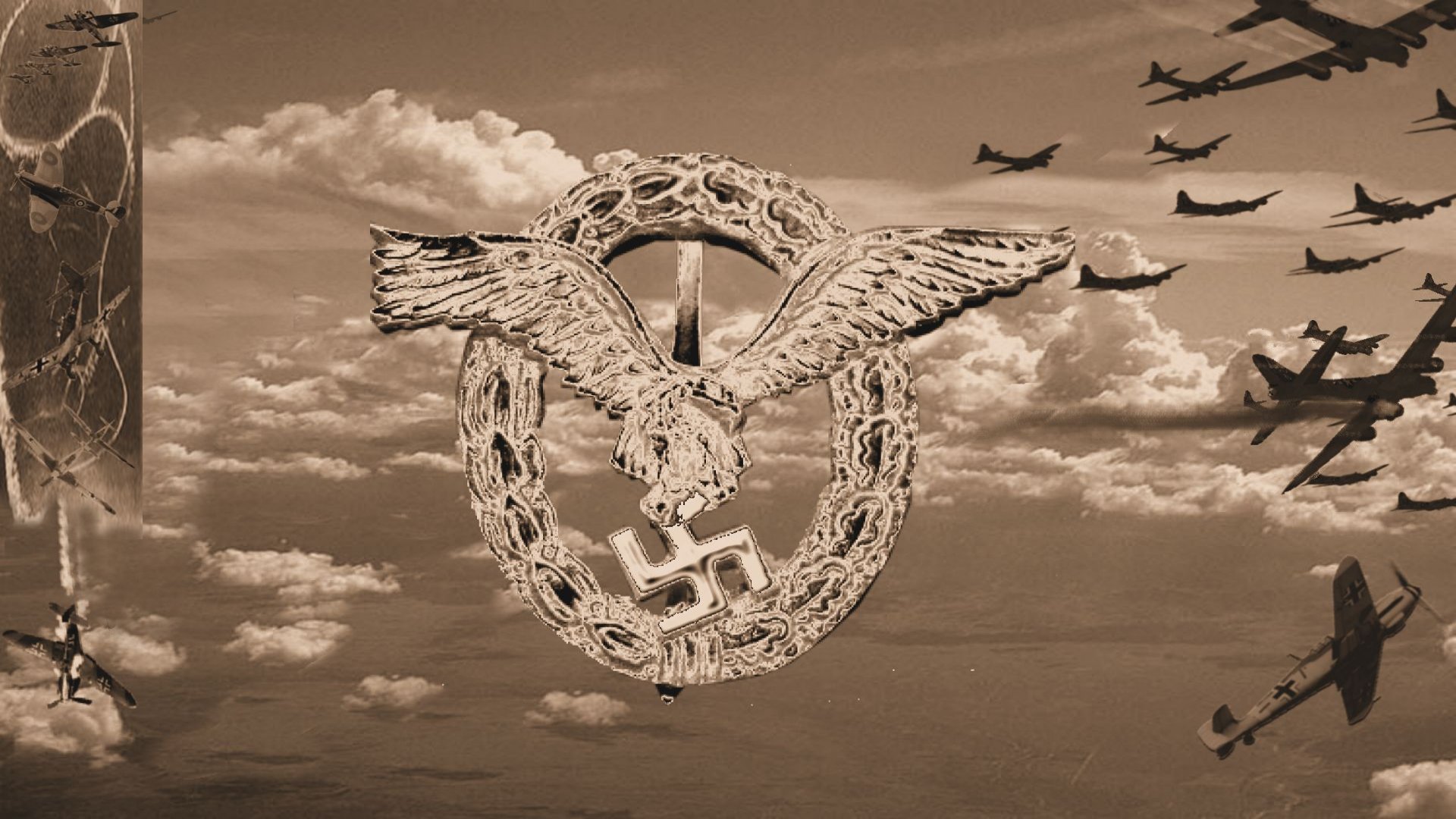 Heinkel He 219 'Uhu' (Owl) Heinkel He 219 'Uhu' (Owl)
The Heinkel He 219 'Uhu' (German:'Owl') was a night fighter that served with the German Luftwaffe in the later stages of World War II. A relatively sophisticated design, the He 219 possessed a variety of innovations, including an advanced VHF-band intercept radar, itself also used on the Ju 88G and Bf 110G night fighters. It was also the first operational military aircraft in the world to be equipped with ejection seats, and the first operational German World War II-era aircraft with tricycle landing gear.
Development
Developed upon the Robert Lusser design of a high bomber (called P.1055) which called for an aircraft designed with a pressurised cockpit, ejection seats and a tricycle landing gear and remotely controlled defensive gun turrets, the basis was laid down for the future development into a superb night fighter for the Luftwaffe. Though initially rejected by the RLM (German Aviation Ministry), Lusser had a variety of wingspans and engine choices as well as presenting the P.1056 design. The RLM later rejected all the proposals causing the luckless Lusser to be fired by Heinkel. However Heinkel, proceeded to fund his venture privately and a prototype was ordered in February 1942 Progress was initially delayed significantly due to the disagreements between Luftwaffe General of the night fighters Josef Kammhuber and Ernst Heinkel and suffered a serious setback in March, when Daimler said that the DB 603G engine would not be ready in time. Instead, they would deliver a 603A engine with a new gear ratio to the propellers, with the new designation DB 603C, and offering the choice of using four-blade propellers, where they finally agreed upon the design in November 1942. Due to in power politics between these two as well as General ,Erich Milch (in charge of Luftwaffe aircraft production, the RLM), production was interrupted for a time. When Kammhuber saw the prototype he was so impressed he ordered into production over Milch's objections, who had rejected the design in January, causing more friction in high command. Milch repeatedly tried to have the He 219 program killed and in the process, Kammhuber was removed from office and transferred to Norway.
Production prototypes were then ordered as the He 219 A-0 and quickly progressed to the point where V7, V8 and V9 were handed over to operational units in June 1943 for testing. The earlier prototypes, fitted out with four-blade propellers for at least the first five prototypes for their DB 603 engines (also used on the Fw 190C prototypes, with the same DB 603 engine) and the quartet of Matratze 32-dipole radar antennas for an early UHF-band Lichtenstein radar installation also possessed cockpit canopies that did not smoothly taper on their upper line going from the rear of the pilot's canopy hatch aftwards, but ended in a nearly semi-spherical enclosure forming the rear of the canopy glazing, with the installation on the "V4" fourth prototype possessing a small degree of internal metal framing in the rearmost canopy glazing, to apparently support a rear dorsal weapons mount, or potentially some sort of sighting gear for the deleted fixed "step"-mount rearwards-firing armament. The last major production version was the A-7 with improved DB 603E engines. The A-7 was typically outfitted with two 20 mm MG 151/20 cannon in the wing roots (inboard of the propeller arcs), two 20 mm MG 151/20 in the ventral weapons bay, and two 30 mm (1.18 in) MK 108s as Schräge Musik. The production was to start in November/December 1944 with 210 aircraft ordered, but it is unknown how many were actually produced. Back to Top
In Action
In June 1943, three He 219s were delivered for combat testing; their first action took place on the night of 11-12 June, where the He 219 designated V9 single-handedly shot down five bombers. Over the next ten nights, the three test aircraft shot down a total of twenty British aircraft. Formal production soon began after the immensely successful combat testing. In order to combat the Mosquito, the He 219 had all excess weight removed. With some weapon and radio systems deleted, the aircraft was able to attain a speed of 650 km/h (400 mph). This version was given the designation A-6. None of these were produced but weight saving measures could be done at the unit level. The He 219 was the only piston-engined night fighter capable of facing the British Mosquito on equal terms, given its speed, manoeuvrability and firepower. One of the top Luftwaffe night aces flying the He 219 was Staffelkapitän Werner Baake of 2./NJG 1 In 195 combat sorties Baake scored 41 victories. At least nine of his kills were achieved while flying the Heinkel He 219. NJG 1 was the only gruppe to be equipped with the He 219, although a small number of aircraft were attached to other units on the western front, including NJG 3.
The He 219 was a complicated and expensive aircraft to build (as well as political rivalry and infighting) which led these factors further limiting the number of aircraft produced and as a result somewhere between 280 to 320 were constructed during the war.
Back to Top
|
 Heinkel He 219 Uhu 3 View
Heinkel He 219 Uhu 3 View
 Heinkel He 219 Uhu Cutaway
Heinkel He 219 Uhu Cutaway
|
Specifications:-(He 219 A-7)
Country of Origin: Germany
Crew: 2
Length: 15.5 m (51 ft 0 in)
Wingspan: 18.5 m (60 ft 8 in)
Height: 4.4 m (14 ft 5 in)
Weight Empty: 8,345 kg (18,398 lb) Loaded: 13,580 kg (29,900 lb)
Powerplant: 2 × Daimler-Benz DB 603E liquid-cooled inverted V-12
Performance
Maximum speed: 616 km/h (333 kn, 385 mph)
Range: 1,540 km (831 nmi, 960 mi)
Ferry range: 2,148 km (1,160 nmi, 1,335 mi)
Service ceiling: 9,300 m (30,500 ft)
Armament
up to 4 × 20 mm MG 151 cannons in a detachable fairing under the fuselage, 300 rpg
2 × 20 mm MG 151s in wing roots, 300 rpg
2 × 30 mm (1.18 in) MK 108 cannons, Schräge Musik (oriented 65° above horizontal), 100 rpg
|
|


